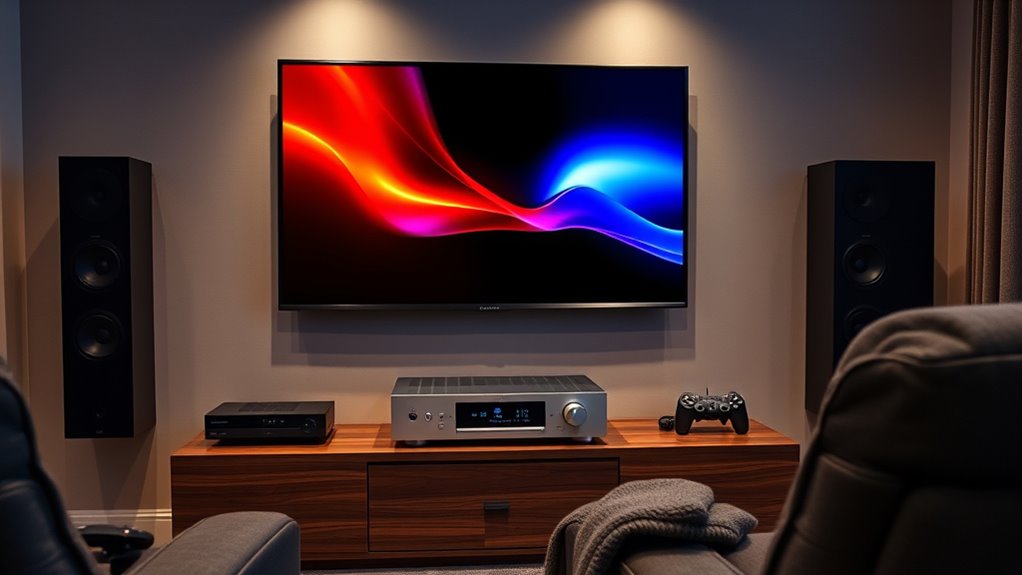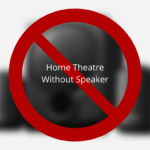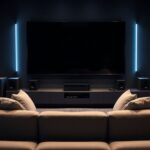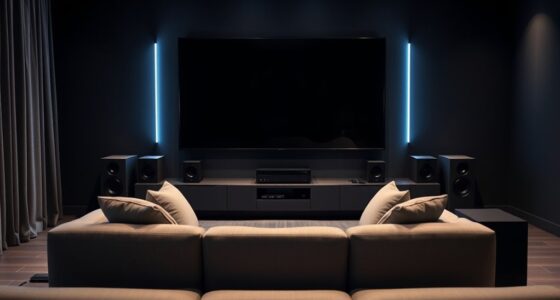To establish an effective home theater system, you’ll need key components like high-quality speakers, a reliable display, and a compatible receiver. Proper calibration and room setup help optimize sound clarity and reduce echoes, while your seating arrangement ensures everyone gets the best view and sound experience. When these elements work together, you’ll enjoy immersive audio and stunning visuals. Keep exploring to discover how each part contributes to creating your perfect home theater environment.
Key Takeaways
- High-quality speakers, including front, surround, and subwoofers, for immersive sound.
- An AV receiver or amplifier to process audio and connect all components.
- A high-resolution display such as a large TV or projector for clear visuals.
- Proper audio calibration to optimize sound based on room acoustics.
- A comfortable seating arrangement positioned for optimal viewing and listening experience.
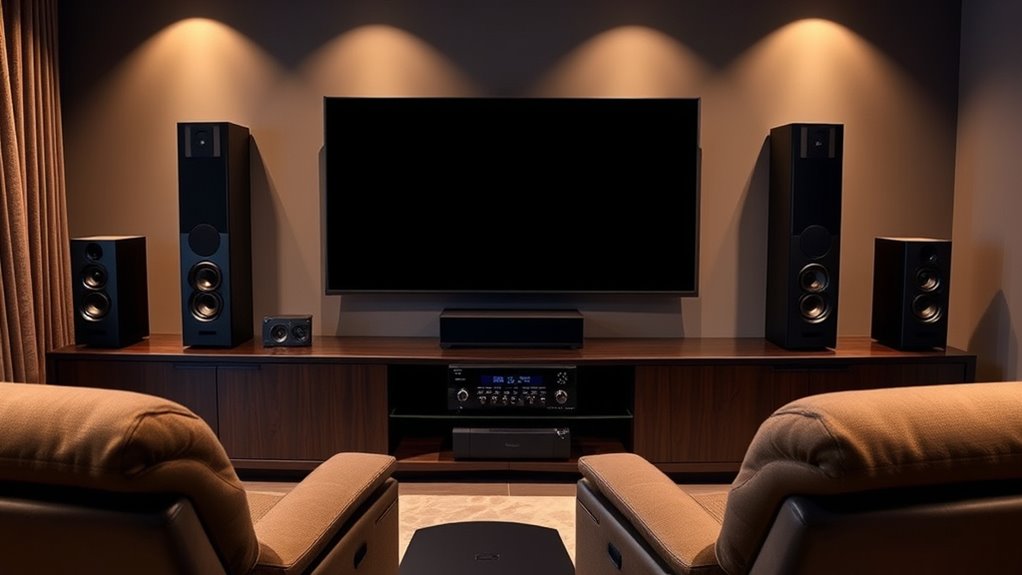
A home theater system brings movie theater quality right into your living room, but to achieve the best experience, you’ll need to understand its key components. One of the most critical aspects is audio calibration. This process involves fine-tuning your sound system to ensure that audio outputs are perfectly balanced and tailored to your room’s acoustics. When you calibrate your audio properly, you’ll notice clearer dialogue, richer sound effects, and a more immersive experience overall. Many modern home theater receivers include automatic calibration tools that use microphones to analyze sound reflections and adjust speaker levels accordingly. However, manual adjustments might still be necessary to perfect the sound, especially if your room has unique features such as large windows or irregular wall shapes. Proper audio calibration eliminates issues like muffled sounds or overly loud bass, making your viewing experience seamless and natural. Additionally, incorporating powerful persuasive words into your setup discussions can help you communicate the value of quality components to others.
Equally important is the seating arrangement. The way you position your seats can considerably influence your overall enjoyment. It’s not just about comfort; it’s about positioning yourself in the ideal spot for sound and picture quality. Ideally, your main seating should be centered directly in front of the screen, at a distance that allows you to see the entire display without strain. A good rule of thumb is to sit about 1.5 to 2.5 times the diagonal screen size away from the display. For example, if you have a 100-inch screen, sitting roughly 150 to 250 inches back provides a balanced view. Additionally, consider the height of your seats relative to the speakers and the screen. Elevate seating slightly if needed, so your ears are aligned with the center of the speakers, ensuring precise sound imaging. Spreading out seating to accommodate multiple viewers also helps everyone enjoy the full surround sound experience, especially when combined with proper audio calibration. You might want to arrange seats in a slight semi-circle or staggered pattern, so each person gets an unobstructed view and ideal sound.
Frequently Asked Questions
How Do I Optimize Acoustics in My Home Theater?
To optimize acoustics in your home theater, start by adding acoustic treatments like bass traps and diffusers to absorb and scatter sound reflections. Use soundproofing techniques such as sealing gaps and installing door sweeps to minimize external noise. Position your speakers correctly and consider adding carpets or curtains to reduce echo. These steps enhance sound clarity, creating an immersive experience with balanced, clear audio throughout your space.
What Is the Best Screen Size for My Room?
You’ll find that choosing the right screen size depends on your viewing distance. A good rule of thumb is to sit about 1.5 to 2.5 times the screen’s diagonal size away from it. For an immersive experience, opt for a larger screen if your room allows, ensuring you don’t strain your eyes. Remember, the best size feels natural and comfortable, making every scene truly enjoyable.
How Can I Improve Wi-Fi Connectivity for Streaming?
To improve your Wi-Fi connectivity for streaming, consider installing Wi-Fi signal boosters to extend coverage and eliminate dead zones. Additionally, using Ethernet over power adapters provides a more stable, wired-like connection, reducing buffering and lag. Position your router centrally and away from interference sources like microwaves or cordless phones. These steps guarantee smoother streaming and a better home theater experience.
What Safety Precautions Are Necessary for High-Powered Equipment?
Think of your high-powered equipment as a fiery beast that needs careful tending. You should secure cables with proper management to prevent tripping hazards and accidental damage. Make certain good ventilation around devices to keep them cool and avoid overheating. Always unplug equipment before cleaning or maintenance, and keep liquids away. These safety steps act as a shield, protecting both your gear and you, ensuring smooth, worry-free performance.
How Do I Balance Audio Levels for Different Content?
To balance audio levels for different content, start with audio calibration using a sound meter or test tones to set a consistent reference. Adjust the volume control on your receiver or remote, ensuring dialogue, music, and effects are clear and balanced. Use the auto-calibration feature if available, but fine-tune manually for ideal sound. Regularly review and tweak settings to maintain a balanced, immersive audio experience across all content.
Conclusion
Remember, a well-rounded home theater system is like a symphony—every component plays a crucial role. When you select the right display, sound system, source devices, and accessories, you create an immersive experience at home. Don’t forget, a chain is only as strong as its weakest link. So, invest thoughtfully in each part, and you’ll enjoy countless movies and shows that make your home the ultimate entertainment hub.
